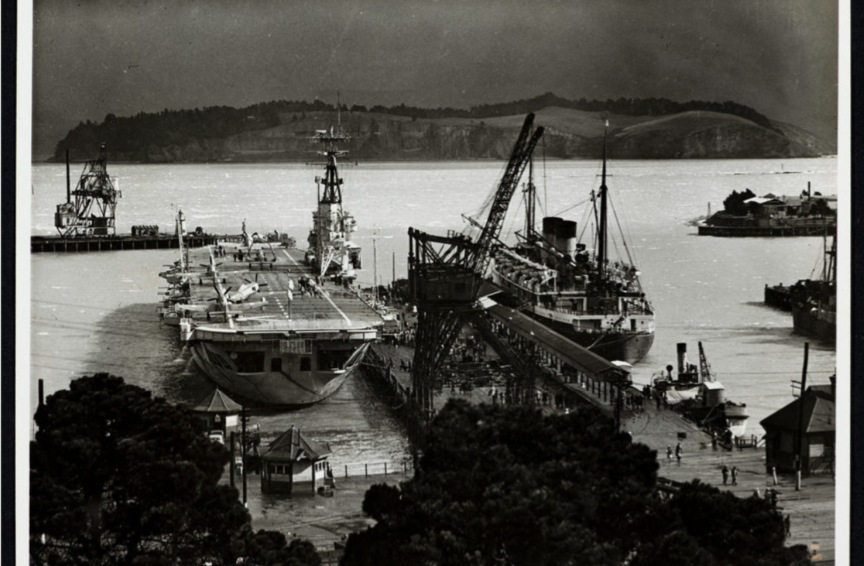PO Box 95
Lyttelton 8841
Te Ūaka recognises Te Hapū o Ngāti Wheke as Mana Whenua and Mana Moana for Te Whakaraupō / Lyttelton Harbour.
HMS Achilles in Whakaraupō Lyttelton Harbour
On Sunday 15 November 1936 large crowds began to gather at the port of Ōhinehou Lyttelton, arriving by motor vehicle and electric train, with extra passenger services having been added to cope with the expected influx of sightseers. The object of the crowd’s curiosity was the latest addition to the New Zealand Division of the Royal Navy, the light cruiser HMS Achilles.
Built by Cammell Laird at Birkenhead in the United Kingdom, she was laid down on 11 June 1931, launched on 1 September 1932, and commissioned into the British Royal Navy on 10 October 1933. A Leander-class light cruiser, she displaced 7,390 metric tons, was 169.3 m in length, with a beam of 17 m and a 5.8 m draught, and carried a full complement of 680 crew. Six Yarrow boilers feeding four Parsons geared steam turbines driving four shafts produced 73,280 shaft horsepower (54,640 kW) for a top speed of 32.5 knots (60 km/h) and a range of 5,730 nautical miles (10,610 km) at a cruising speed of 13 knots (24 km/h). The Achilles main armament consisted of eight 6 inch (152 mm) guns in four twin turrets fore and aft. This formidable array was complemented by four 4 inch (102 mm) coastal defence and heavy anti-aircraft guns, twelve Vickers machine guns, and eight torpedo tubes.
HMS Achilles was the first British warship to carry the catapult-launched Supermarine Walrus amphibious plane, later also fitted to the Royal Australian Navy’s flagship HMAS Canberra. Newly designed and built at Supermarine’s Woolston, Southampton UK facility, the Walrus was unique for its time with an all-metal fuselage, and was used in reconnaissance, rescue, and anti-submarine duties. Aside from the Walrus, the Achilles would later make use of a novel radio controlled aerial drone, the DH.82 Queen Bee.
After serving with the British Home Fleet for two years, in November 1935 HMS Achilles was assigned to the Royal Navy’s New Zealand Division. While RN warships were traditionally crewed by British sailors, the formation of the New Zealand Royal Naval Volunteer Reserves (RNVR) in 1926 had led to a growing cadre of New Zealand born seamen serving with his Majesty’s naval forces. A decade later, when Achilles was recommissioned into the New Zealand Division on 31 March 1936, a majority of her crew were proudly New Zealand born and bred. As the modern flagship of a naval service that was well on its way to becoming the New Zealand navy, it’s no wonder she drew ‘huge crowds’ on her inaugural cruise around the country. After calling in at Wellington from 9 to 12 November she embarked for her second port of call at Whakaraupō Lyttelton Harbour arriving 13 November 1936.
The welcome activities began early with a complement of crew from Achilles marching in good order to Saint Saviour’s Church in West Lyttelton to attend a service led by Reverend Malden. By 1:45 pm the crowd on the wharf had grown so large the gangways were opened early to accommodate the 7,500 people who patiently waited their turn to inspect ‘their’ cruiser through to 6 pm that evening. The following morning, 170 ratings, including the Royal Marines’ band and seven officers, marched through the streets of Ōtautahi Christchurch from the railway station, up Manchester Street to Cathedral Square where the salute was taken by Mayor Beanland. Following this, the crew were treated to morning tea at Christ’s College.
The Achilles left Lyttelton port on 17 November, calling at Akaroa and Dunedin before sailing up the West Coast and finally arriving at Auckland on 3 December 1936. Just three years later she would join HMS Exeter and Ajax in a deadly engagement with the Kriegsmarine heavy cruiser Graf Spee. The first naval engagement of WWII, the famous Battle of the River Plate would lead to the loss of four of Achilles seamen on 13 December 1939, followed by the self-destruction of the Nazi warship in the harbour of Montevideo.
On 1 October 1941 the Royal Navy finally ended its long association with the British Crown’s Australasian Dominions when the Royal New Zealand Navy (RNZN) was decreed, and the HMNZS Achilles was recommissioned once again. This famous New Zealand cruiser would go on to see action in the Pacific war at Guadalcanal in 1942-43 and at Okinawa, Japan in 1945. At war’s end, Achilles returned to Royal Navy service in the UK in September 1946, having only been on loan to the RNZN, and was then sold on to the Indian Navy where she was commissioned as INS Delhi in July 1948. After a further 30 years of service, she was scrapped in Bombay on 30 June 1978. In commemoration of her service with the RNZN, the Indian government gifted her stern Y turret and guns to Auckland’s Devonport Naval Base where they reside at the entrance to this day.

